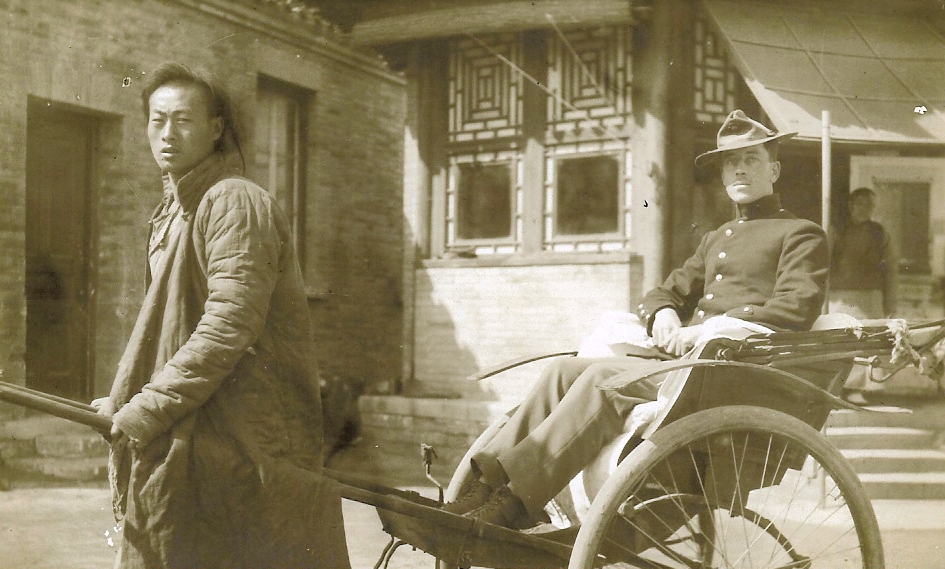
1818
-The Frigate USS Congress is dispatched to Lintin Island, near Canton, China for a trade protection mission. Onboard the USS Congress a detachment of Marines under 1Lt William Nicholl
1835
-US Navy established a East India Squadron at Hong Kong
1839-1842
- England and China engage in the 1st Opium War. The treaty of Nanking that ended the conflict opened a number of Chinese ports to foreign trade
1844
-Feb US Marines provide a temporary guard for Caleb Cushing who was serving as a minister to China and based in Macao
-Jun US Marines from the USS St Louis open fire on a Chinese mob that was attacking the US Legation in Macao
1853
-Marines aboard the USS Mississippi, anchored on the Canton River, at the request of the Captain of a Siamese warship whose crew had mutinied, boarded the Siamese vessel and suppressed the munity and restored the ship to its officers.
1854
-5 Apr. 60 Marines and sailors from the USS Plymouth alongside English Marines and sailors drive off Imperial Chinese troops that occupied a portion of the international settlement in Shanghai. Only one Marne was wounded as a result ofthis action.
1855
-19 May. Marines from the USS Powhatan landed in Shanghai as a consequence of chaotic conditions within the Chinese section of the city
-Aug. Again the Marines of the USS Powhatan are called to join British forces in combating pirates operating along the Chinese coast. After a sharp action on Ty-ho Bay the Allied force captures or destroyed 18 Pirate junks. Two Marines are killed.
1856
-Oct. As a result of clashes between the British and Chinese around Canton, Marines landed to protect American citizens there.
-16 Nov US Naval Commander Foote’s boat was fired upon by the forts near Whampoa. As a result, the US Navy bombards the forts and lands Marines and sailors to reduce the forts over the next month.
1857-58
-The Second Opium is fought between the Chinese and the English and their French ally. The Treaty of Tientsin opened up a number of additional ports to foreign trade mission.
1859
-31 Jul A small force of Marines and sailors land in Shanghai at the request of the American Consul there in anticipation of trouble resulting from fighting between the Imperial Chinese and French and English forces off Taku.
1866
-25 Jun. Chinese authorities refuse to arrest the ring leader who lead an assault on the US Consul at New Chwang. Marines are ordered to bring the ring leader to justice. They find and arrest him and upon trial turn him over to Chinese authorities.
1894
-1 Aug Start of the Sino-Japanese War.
-6 Dec Because of anti-foreign riots in Pekin, the American Minister, Charles Denby, requests Marines provide a Legation guard. Capt George Elliott and the USS Baltimore’s -Marine detachment arrives Tientsin to fulfill Denby’s request but the Chinese deny the Marines entry to the city. The detchment remains in Tientsin.
1895
-Feb. Denied the use of rail access to Pekin by the Chinese, Capt Elliot and a Naval Paymaster travel on horseback to the city. They remain, serving as informal attachés.
-10 May End of the Sino-Japanese War
-16 May Capt Elliott and the Baltimore Marines return to their ship
1898
Chinese reform movement compounded by the power struggle between the Emperor and the Dowager Empress promotes anti-foreign riots in Pekin.
4 Nov Marines are again requested to serve as Legation Guards. They arrive in Pekin on this date to serve as Legation Guards under the Command of 1Lt Robert 1st Lt Robert McM Dutton.
1899
-15 May As the situation stabilizes in Pekin, the Marine Legation guard is once again withdrawn.
1900
-Boxer Uprising. Born as a Chinese nationalist movement centered in the north of the country and initially focused on hostility to the ruling Manchu dynasty, over the first part of 1900 was diverted into an anti-foreign movement by the ruling Manchu’s. With Boxer attacks on foreigners increasing and repeated attempts of the foreign ministers to the Chinese government to control the Boxer’s the foreign ministers request legation guards be sent to Pekin.
-29 May. American Marines and several U.S. sailors begin to disembark from their ships off Taku in response to a request from the American Minister in Pekin for assistance in guarding the Legation.
-31 May. Those Marines and sailors identified as Legation Guards, along with other Allied soldiers and sailors arrive in Peking to defend the Legation quarter of the city.
-19 Jun. Additional Allied forces, including U.S. Marines, under the command British Admiral Seymour are repulsed while attempting to relive the Legations in Peking.
-3 Jul. In besieged Peking, Capt Myers, USMC leads a successful multi-nation attack against the Chinese barricades on the Tartar Wall. Capt Myers is wounded in the assault
-13 Jul Battle of Tientsin. Marines from the Asiatic fleet and the Philippines are a part of the foreign force repelled by Chinese Army and Boxers forces while attempting to lift the siege of Pekin.
-14 Jul As a result of Japanese efforts the Allies take Tientsin
-15 Jul Pvt Dan Daly’s lone stand on the Tartar Wall earns him his 1st Medal of Honor
-3 Aug A new a larger international relief force, including U.S. Marines, leaves Tientsin for Pekin. The senior American Commander is US Army general Gen Adna Chafee
-13 Aug After heavy fighting, the international relief force finally reaches Pekin and relieves the Legation garrisons. As a result of the siege, the American Legation complex is damaged and must be rebuilt
-28 Sep Along with other US Army units involved in the China Relief Expedition, the Marines involved in the defense/relief of Peking ordered by Gen Chafee to return to their ships or home bases
1901
Feb Congress allocates $20,000 to buy land in Peking for a new Legation complex. The land chosen is to the west of the old American Legation
-April. Construction begins on the new Legation Guard barracks
-May Major General Chaffee ordered to withdraw the bulk of US forces in Peking, apart from a company of 9th US Infantry, and some supporting forces, under Army Major E.B. Robertson commanding. In the interim, US forces are billeted in undamaged portions of the old American Legation
-7 Sep The Boxer protocol is signed between Allied powers and China. Article VII allows the Allies the right to station troops in the Legation Quarter of Peking and Article IX to protect lines of communications between Peking and the North China coast
1902
-Feb Major Andre Brewster, US Army, relieves Major Robertson as Legation
Guard commander
-Summer American Guard compound is completed and occupied by Company B of the 9th Infantry
1905
-May Capt Henry Leonard, USMC, arrives Peking as the first Marine attaché and first permanent Marine presence in Peking
-Jul As the result of harsh U.S. Anti-exclusion laws a number of Chinese implement a boycott of American goods. Riots occur in several Chinese cities. Marines from the USS Baltimore land in Shanghai on the possibility that they will be called upon to protect American lives
-Jul Following an on-going debate between the Army and the Navy on who should guard the American Legation in Peking, President Roosevelt defers to the American Minister in Peking, William Rockhill, to settle the issue. Rockhill chooses Marines and formally requests their presence in Peking. Soon thereafter, HQ USMC issues orders to the commanding officer of the 1st Brigade of Marines in the Philippines to detail two officers and 100 picked men to serve as Legation Guards
-4 Aug. Capt Harry Lee and 1Lt Thomas Holcomb are ordered to Olongapo, Philippines Islands to assemble the new Peking Legation Guard Company. The Marines travel with Secretary of State Taft and Alice Roosevelt who was departing the Philippines to continue the next leg of their Far Eastern diplomatic mission to China onboard the USAT Logan
-28 Aug. The Marine Legation Guard Detachment departs Philippine Islands for Taku China, via Hong Kong, and Chefoo
-11 Sep. Following a visit to Hong Kong/Canton, Secretary Taft returns to the USA, via Shanghai while USAT Logan with Ms. Roosevelt and the Marines arrive off the Taku Bar to join the US Asiatic Fleet. Marines disembark and head toward Peking
-12 Sept. Marines formally relive B Company, 9th US Infantry and assume duties as the legation Guard to the American Minster of China.
-20 Dec. Marines and blue jackets from the USS Baltimore land in Shanghai to help preserve order alongside sailors and Marines from Britain, Germany, and Japan in response to anti-foreign rioting. The landing force re-embarks aboard the USS Baltimore on 4 Jan 06
1906
-Diplomatic portion of the legation compound opened
-Apr. Capt William Clifford relieves Capt Lee as the Legation Guard Commander
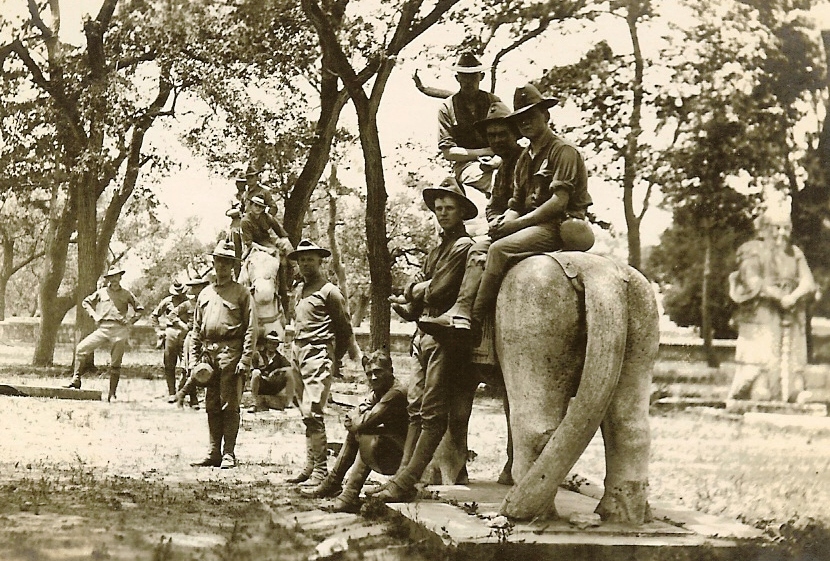
1907
-17 Jan. A number of Legation Guard Marines are accused of “wrecking a Korean resort” in Peking. Many are court-martialed for “pillaging a native house”
-Capt Louis Gulick relieves Capt Clifford as the legation Guard Commander. Over his career Gulick will serve three tours as Guard Commander
1908
3 Mar LtCol George Barnett, assumes command of the American Legation Guard. He will be later joined by his wife and children
1909
-May. Lt Col Barnett leads the legation Guard on a conditioning march from Peking north to the Great Wall. The Marines would continue to intermittently make this an annual training event up through WWI.
1910
-May. Using a new Office of Naval Intelligence program, the Marines nominate two officers (Capt Thomas Holcomb and 1Lt E.L. Bigler) to serve in Peking for the purpose of studying the Chinese language. The program will discontinued in 1916, but be reestablished in 1926
-14 Nov. Maj John H. Russell, accompanied by his wife and daughter, assumes command of the Legation Guard. His daughter is the future socialite Brook Astor
1911
-11 Oct. Wuchang China, start of the Chinese Revolution. Marines on the USS Helena are across the river at Hankow and will assist in brining Americans to safety. Over the next several weeks the revolution moves norht toward Peking
-17 Oct. At the request of the American Minister in Peking, the USS Abarenda dispatched from the Philippines with additional Marines troops to reinforce the Legation. They arrive at the port of Tangku and train in to Peking . Augmented with reinforcements from the Philippines, the Legation guard force is now split into “A” and “B” Company.
-26 Oct. The USS Rainbow is dispatched from the Philippines with four Marine companies, under Maj Philip Bannon to serve as an expeditionary force cruising along the coast of China in case of need.
-Early Dec. An additional company of Marines arrives in Peking via the USS Abarenda
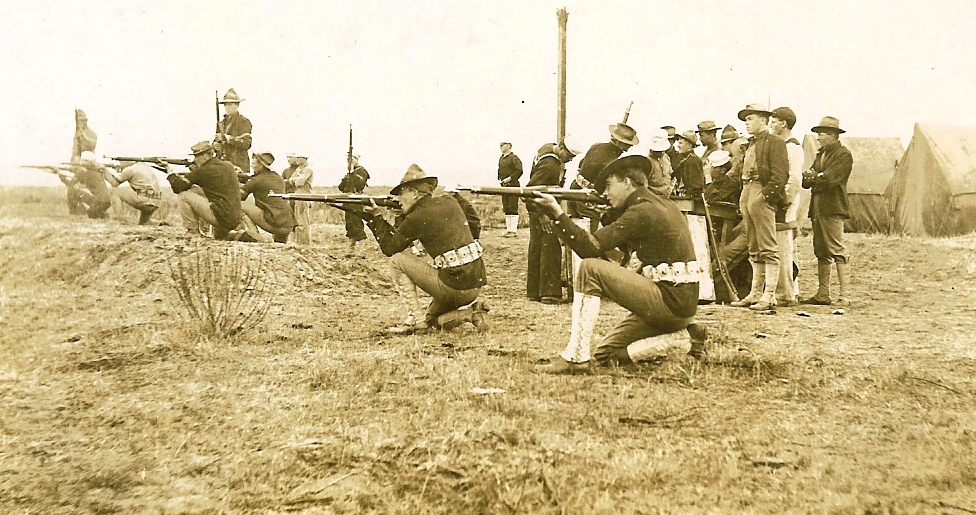
1912
-1 Jan. Republic of China established. Dr. Sun Yat-Sen is selected as the provisional president but soon agrees to yield to General Yaun ShiKai
-18 Jan. The first elements of the US Army’s 15th Infantry arrives China to join a multi-national force held in readiness to keep the railway lines open between Peking and the coast. They will ultimately be garrisoned in Tientsin
-Jan-Feb. Marines establish a Mounted Detachment in Peking. Original strength: one sergeant, three corporals and twelve privates.
-12 Feb. Abdication edict was issued by Empress Dowager Longyu
-15 Feb. An Imperial General, Yuan Shikai, elected Provisional President by the Nanking Assembly
-29 Feb. Following the arrival of rebel delegates from Nanking to Peking, the Chinese 2nd Division riot throughout the city. That night the Allied ministers in Peking fear the violence will be directed against foreigners and order all the legations guard units to secure the Legation Quarter of the city. As rioters run throughout the city, looting and killing their fellow Chinese citizens, whole sections of Peking burn.
-1 Mar. Executing established contingency plans, Allied forces seal the Legation Quarter. US Marines are responsible for covering the western end of the Allied defensive line. Working throughout the night the Marines sandbag the entrance to Legation Street and establish fighting positions in front of their compound and along the Tartar wall. Furthermore, they occupy the Chien-Men Tower, which they don’t return to Chinese control until 1920
-2 Mar. At the request of the U.S. Minster, two hundred men of the U.S. Army's 15th Army Infantry arrive in Peking from Tientsin to further reinforce the Legation garrison.
-3 Mar. In a show of strength the Allied forces parade through Peking. They are cheered by a number of Chinese citizens
-9 Mar. With the arrival of Maj Bannon’s China Expeditionary Force at Tientsin, the forwarded deployed elements of the 15th return to Tientsin
-10 Mar. Yuan Shikai is sworn in as President of China. Maj Bannon’s brings two Marine companies from Tientsin to Peking to further reinforce the Legation Guard Detachment
-Nov. 1st Marine wireless station is established in Peking allowing the Detachment communications with elements of the US Asiatic fleet, as far away as Shanghai
1913
-Apr. Maj Russell departs Peking and is relieved by Maj Dion Williams
-Jul-Sep. The 2nd Chinese Revolution. Seven southern providences rebel against the central Republican government. Republican forces crush the rebels. Marines witness the fighting along the Yangtze Valley
1914
Marine Companies change from letter to number designations. The Legation Guard Companies are now identified as the 38th and 39th Company
Summer The Legation Guard Compound is fully landscaped
-28 July. World War I begins. War comes to China as Japan and Great Britain commence the assault on the German colony of Tsingtao starting with a blockade in Aug. The nearby American Asiatic fleet summering at Chefoo, quickly moves south to Shanghai to avoid the fighting around Tsingtao. From 1914 through Apr 1917 America remains neutral in the conflict. Various nations begin withdrawing or reducing their Legation forces in Peking.
1915
-18 Jan. Japan issues “21 Demands” to China that would have greatly expanded Japan influence in China
Dec Col Wendell Neville assume command of the Marine Detachment, Peking
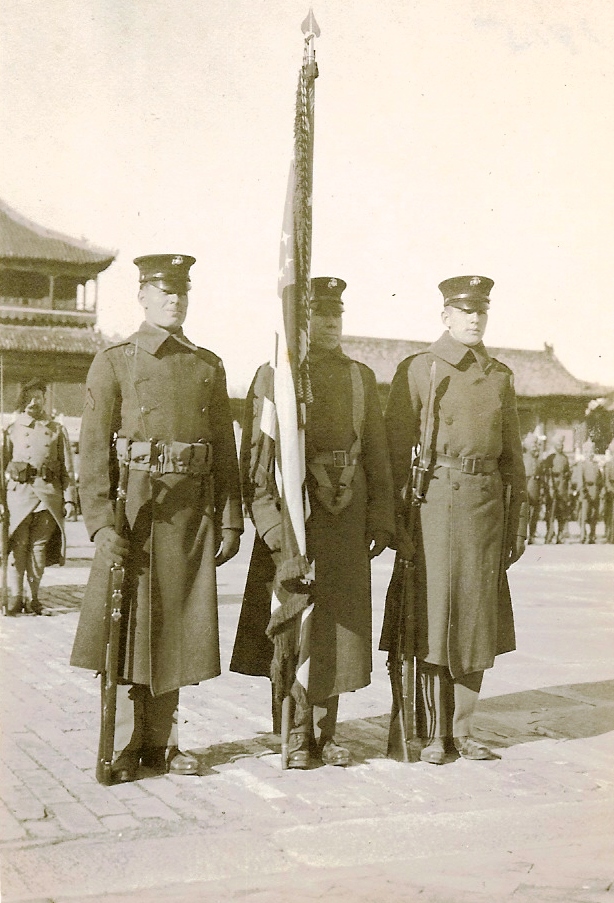
1916
-5 Jun. President Yuan Shikai dies. At Yuan’s funeral procession, Col Neville in dress whites marches alongside military representatives from all the world powers that maintain Legations in Peking. This must be one of the last times Imperial Austrian, Russian and German officers marched alongside their French, Japanese, English and American counterparts as all were or soon would be at war with each other.
1917
-1 Jul. An attempt by General Zhang Xun to restore the young Manchu Emperor is crushed after two weeks by forces loyal to the Chinese Republic. However, in response to the fighting in Peking the American Minister requests a Company of the 15th Infantry assist in garrisoning the U.S. Legation. Again the legation Quarter is sealed with the Marines taking up defensive positions. After two weeks the crises passes and the 15th returns to Tientsin
-13 Aug. China declares war on Germany and Austria-Hungary and enters WWI on the side of the Allied Powers in hopes of regaining German spheres of influence in China
-6 Apr. America enters WWI also on the side of the Allied Powers
1918
In Peking, the old West Barracks in the Legation Compound is torn down and replaced by a new three story West barracks. The Marine Guard is temporarily billeted in the old Russian Legation barracks.
- 28 Nov. In honor of the Armistice, China declares a national day of celebration. Chinese troops and Allied troops from the Legation Guards march through the city together and enter the Imperial City to celebrate the end of the conflict.
1919
4 May. 4 May Movement protest by lead by Chinese students in Peking over the terms of the Treaty of Versailles and Japans attempt to formally acquire the former German colony of Tsingtao results in street unrest
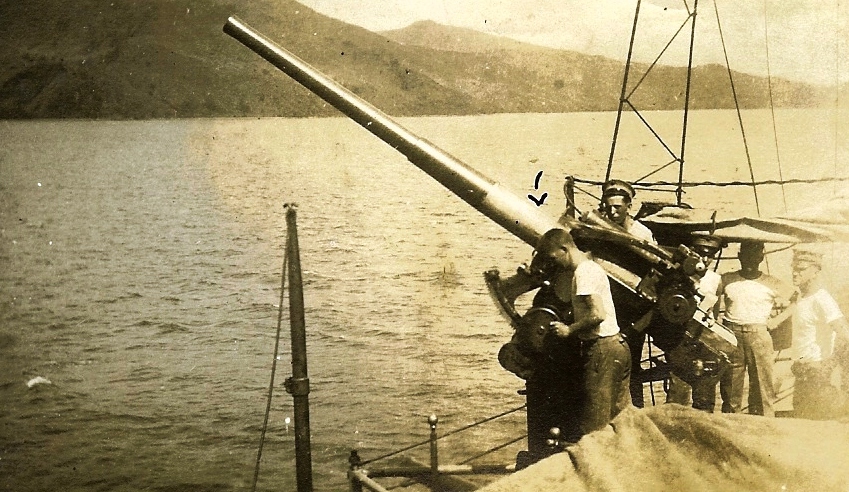
1920
Following WWI, and as a result of the drawing down of military forces in Peking, the Marines now maintain the largest Legation guard presence in the city, even larger than the Japanese.
1922
-30 Apr. As a result of fighting near Peking between Warlords Wu Pei-fu of Shangtung and Chang Tso-Lin of Manchuria, Marines seal their portion of the Legation quarter. Furthermore, Marines open fire from the Tartar Wall on rebel soldiers attempting to use a ram on the Chien Men gate.
-5 May.150 US Marines from the USS Huron landed at Tientsin in response to fighting between Gen Wu Pei fu and Gen Chang Tso-lin’s troops near Peking. They remain for several days in case they are need in Peking. Marine Legation guard strength is now 525.
American Minster Shurman dispatches a Marine detachment from Peking to guard American Missionaries near Tungchow
-30 Jul. First issue of the Legation Guard Newspaper published. Although the name will change over the years the newspaper/magazine will remain in publication up until November 1941
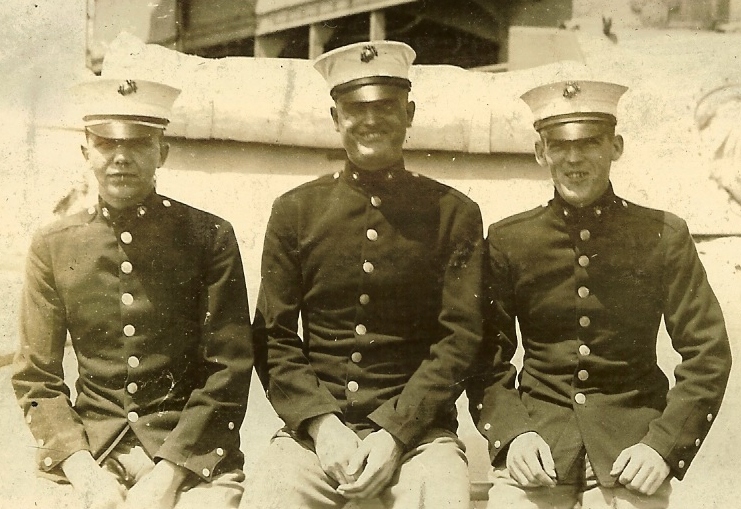
1924
-July Col Louis McCartney Little assumes command of the Legation Guard detachment
-Fall A new conflict between Chinese warlords again threatens Peking. The American Minister requests additional Marines to augment the Legation Guard. 225 Marines from the USS Huron and the Philippines are dispatched to the Legation and an additional 50 to Tientsin.
1926
-USMC reestablishes the language program in Peking
1927
-3 Feb. In response to fighting between Chiang Kai-Shek’s Nationalist Chinese forces and forces under Northern Warlords, along the Yangtze Valley the 4th Marine Regiment sails from San Diego for China aboard the USS Chaumont
-24 Feb. The USS Chaumont arrives at Standard Oil Company docks in Shanghai. A part from only liberty parties the 4th remains on the ship until the State Department and the Military came to an agreement on the roles of the 4th marines in Shanghai.
-21 Mar. The 4th Marine Regiment disembarks from the Chaumont and moves into a series of billets around Shanghai. Marines patrol a section of the International Settlement
- 6 Apr. In response to a Chinese police raid on the Soviet Legation in Peking, US Marines now guard the Soviet compound which is adjacent to its own.
- May. Marines in Shanghai stop patrol duty and return to their billets within the city.
- May. In response to continued advances toward Peking, by the Nationalist forces Gen Smedley Butler shifts the 3rd Brigade, minus the 4th Marines, from Shanghai to Tientsin
- 4 Aug. Lt Col Thomas Holcomb returns to China to command the Legation Guard Detachment
1928
- Kuomintang government changes the name of Peking to Peiping
- Legation Guard YMCA begins a series of tours designed for Marines assigned to the Legation
1929
-Mounted Detachment acquires Patton sabers and Thompson guns.
-First reference to the Company Diamond being worn by Legation Guard Marines on their Winter fur caps.
-Jan. Gen Smedley Butler’s 3rd Brigade is withdrawn from Tienstin, returning stateside
-20 Mar. A third Legation Guard Company, the 62nd, is established from the existing Causal Company. The Legation guard will retain one headquarters company and three line companies through Feb 1938
1930
-28 Jan. Colonel James Breckinridge assumes command of the Legation Guard
Feb The 4th Marine Regiment is now an expeditionary force and its name is changed to the 4th Marines.
1931
-Sep. Japanese attack China and seize Manchuria.
1932
-28 Jan. 28 January Incident”. Following the 18 January beating of five Japanese Buddhist monks by Chinese civilians, Japanese carrier based aircraft bombed Shanghai followed by a land attack of Japanese forces in the area. Marine execute their Plan “A” and guard four miles of the Soochow creek.
-5 Feb. The 4th Marines are augmented with 67 Marines from the USS Houston. In addition the USS Chaumont arrived in Shanghai with the 31st US Infantry.
-5 May. Sino-Japanese fighting in Shanghai ends as a result of a cease fire agreement
1933
-1 Jan. Marine Companies lose their number designations and revert back to letter designators. In Peking, line companies are now numbered A, B and C
1935
-1 Oct. With the establishment of a US Embassy in China, the Marine Detachment, Peiping is formally designated an Marine Detachment American Embassy, Peiping
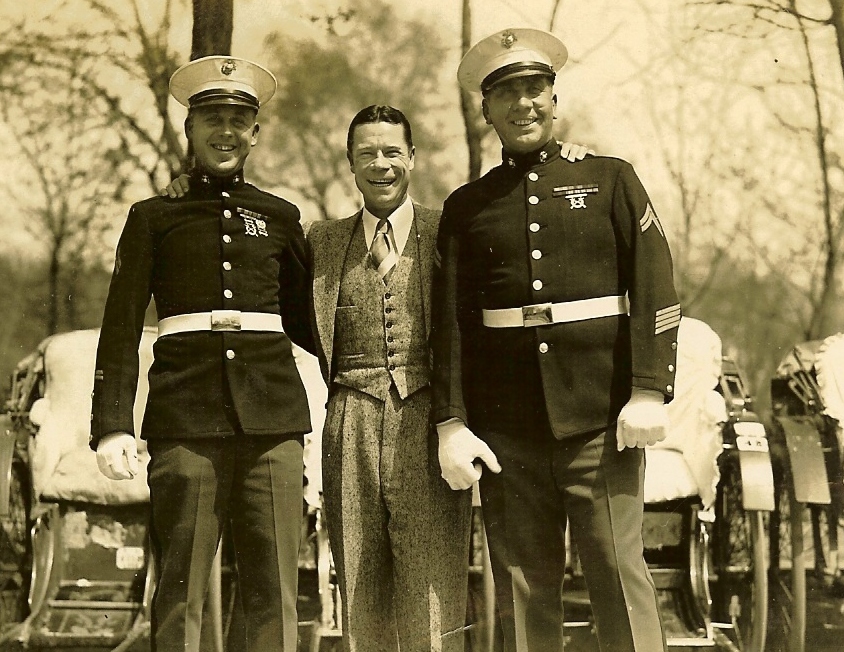
1937
-7-9 Jul. Marco Polo bridge incident, south of Peking results in clashes between Chinese and Japanese forces
-25 Jul. Following the 7 July Bridge incident, full scale fighting begins between the Chinese and Japanese at Langfang near Peking
28 Jul Japanese forces capture Peking
-11 Aug. Japanese attack Shanghai following the deaths of two Japanese marines at a Chinese airfield
1938
-27 Feb. The US Army’s 15th Infantry withdraws from Tientsin and the Embassy’s Marine Guard detachment is split up to cover the duties formally done by the 15th in Tientsin. As a result, the Embassy detachment is reduced to a headquarters company and two line companies. At this time the Mounted Detachment is formally disbanded.
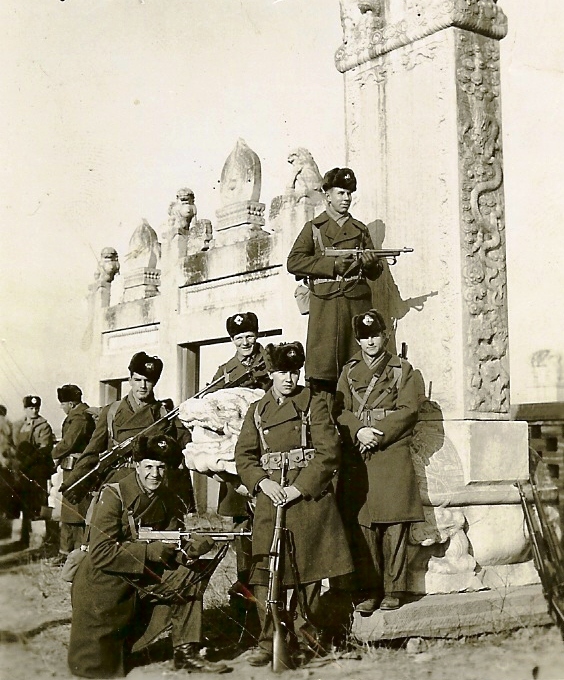
1939
-Jun. Japanese forces run barbed wire around the English and French concessions in Tientsin. This results in restricted movement throughout the city
-20 Aug. As a result of heavy rains north and west of Tientsin, large portions of Tientsin, including the Marine barracks are flooded. The Marine compound will remain under 44 inches of water until the end of September when the flood finally recedes
1940
- May. The last full draft of Marines for China service are sent over
1941
-14 May. Colonel Peck is replaced by Colonel Samuel Howard.
-August. Along with Admiral Glassford of YANGPAT and Consul general in Shanghai, Frank B. Lockhart bring concerns for Americans in China and send recommendation to Secretary of State Hull for withdrawal of Marines from China.
U.S. Ambassador Clarence Gauss (insert photo) wanted Marines to stay.
-10 Nov. Washington orders Marines out of China
-27-28 Nov. 4th Marines depart Shanghai and head for the Philippines where they will fight the Japanese until their May of 1942 surrender.
-8 Dec North China Marines surrender. Following their attack on Pearl Harbor, Japanese forces surround US Marine detachments in Peiping, Tientsin and Chinwangtao and demand their surrender.
1942
-10 Jan. The Japanese consolidate all the captured North China Marines in the Marines Tienstin complex.
- Jan. The entire group of 203 North China Marines sent to a POW camp at Woosung, outside Shanghai where they joined approximately 1100 Marines and civilians captured earlier on Wake Island.
-
1943
-11 Jan. The U.S. Government renounces its Extraterritoriality Rights resulting from the Boxer Protocols of 1901.
1945
-30 Sep. The 1st Marine Division arrives off Taku in preparation for landing.
-6 Oct. Japanese forces in the Tientsin-Tangku-Chinwangtao areas surrender to the Marines.
-7 Oct. Marines return to Peiping. 5th Marines occupy the Legation Quarter of Peiping.
-10 Oct Japanese forces around Peiping surrender
1946
- 10 Jan: General Mashall mediates a cease fire agreement between the Chinese Nationalists and Communists. It is to take effect midnight 13 Jan.
- 15 Jan: MAG-25 transports assist in moving truce teams around China and dropping leaflets announcing the cease fire.
- 8 Mar: The headquarters of the 4th Marines is formally rejoined to the 6th Marine Divsion in North China.
- Apr: MAG-12 headquarters retruns to the United States from China. The group's remaining squadrons in China are transfered to MAG-24.
- 1 Apr: The 6th Marine Division is deactivated and replaced in North China by the nearly activiated 3rd Marine Brigade. It consists of the 4th Marines and supporting units.
- May: MAG-32 returns to the United States from China.
1 May: Operational control of Marine forces shifts from theater command which is dissolved to the US 7th Fleet.
21 May: Chinese Communist forces clash with 1st Div Marines near Tientsin. One Marine is killed
6 Jun: MAG-25 departs Tsingtao for El Toro
10 Jun: Headquaters of IIIAC is disbanded and the headquaters of the 1st Marine Division assumes a dual role as Marine Force China. The headquaters 3rd Marine Brigade in Tsingtao is disbanded with the 4th Marines assuming its functions.
7 Jul: Chinese Communists issue a manifesto attacking U.S. support of the Nationalist Government.
13 Jul: Communist forces captures seven Marines visiting a village near Peitaiho.
15 Jul: 1st MAW reports aircraft availability at 20% due to lack of trained maintence personnel/ The last ship repatriating Japanese nations form China sails from Tangku. Over two million troops and civilians had moved back to Japan.
24 Jul: Negotiations results in the release of the seven Marines captured by Communist forces near Peitiaho.
29 Jul: Communist forces ambush a supply colnvoy on the road to Peiping. Marines from 1/11 and the 1st Marines hold off the attacking force throughout the afternoon, until the enemy breaks contact. Marine losses are four killed and 10 wounded.
3 Sep: The 4th Marines (less 3/4) embark at Tsingtao for the U.S.. 3/4 comes under command of the Naval Port Facilities Tsingtao.
6 Sep: Marine guards are assigned only to trains transporting American personnel or supplies. The Chinese Nationalist Army assumes responsibility for protecting all other rail traffic, including coal trains previously guarded by Marines.
3 Oct: Communist forces make a night raid on the 1st Marine Division's main ammunition supply point at Hsin Ho. The guard force drives them off without losing a man.
1947
- 5 Jan: 7th Marine, VMO-6 and other air units, and their ground support elements depart Chinwangtao for Hawaii
- 6 Jan: Announces the U.S. will no longer particpate in truce enforment efforts
- 16 Jan: The remainder of the 11th Marines, 1st Tank Battalion and the ground units of VMF-115 depart Chinwangtao for the U.S.
- 3 Feb: 1st Marines recieve orders to cover the withdrawl of U.S. personnel from Peiping and prepare to depart the country
- 10 Mar: Elements of 1st Pioneer Battalion departs for Guam
- 26 Mar: Planes from VMF-218 deaprt for Guam
- 5 Apr: Just before dawn a Communist force attacks the ammunition supply point at Hsiin Ho, while other Communist troops ambush the reflief company. Marines suffer five killed and sixteen wounded
- 1 May: Fleet Marine Force Western Pacific (FMFWESPAC) is activated at Tsingtao to control the remaining Marine forces in China after the 1st Marine Division and 1st Marine Air Wing depart
- 12 May: Last elemetns of the 5th Marines (minus 1/5) depart Peiping and the regiment sails for Guam
- 23 May: Marines evacuate civilians from Peitaiho Beach
- 24 May: 1/5 sails for Guam
26 May: 1st Pioneer Battalion leave Peitaiho for Tientsin
- 20 Jun: Remainder of 1st Marine Division (minus a few select elements) sail for the U.S. The 1st Marine and 3/4, and two squadrons- VMR-153 and VMF-211 and 12th Service Battalion remain at Tsingtao. 1/1 remains garrisoned in Tientsin to guard Naval installations and protect remaining U.S. civlians remaining in China
- 27 Aug: 1/1 departs Tientsin for the U.S. Only Marine forces in China remain at Tsingtao
- 25 Dec: Five Marines on a hunting trip cross into Communist controlled territory and after a firefight, are captured
1948
- 31 Jan: Marine patrol engages in a firefight with Chinese Communist forces near Tsangkou Airfield
- 13 Feb: Chinese Communist forces announce they have captured 5 Marines on 25 Dec 1947 and one Marine had died from wounds
1 Apr: Communist forces release the four captured Marines
10 Apr Communist forces capture four Marine airmen when their transport is forced to make a emergency landing due to mechanical reasons.
- 2 Jul: Communist forces release the four captured Marine Airmen.
- 14-18 Nov: Small detachments of Marines return to Peiping and Tientsin to assist in evacuating American citzens.
- 17 Nov: SecDef Forrestal announces that an additional 1,250 men from Guam will be sent to Tsingtao to reinforce the 3,000 men of FMFWESPAC. A platoon of Marines is sent to Nanking to protect the U.S. Embassy
- 28 Nov: The SecDef announces the 9th Marines will be sent to Shanghai to assist in the evacuation of Americans
16 Dec: Acting Secetary of State announces the Marines will remain committed to not getting involved in the Chinese civil war and will only fight if fired upon
1949
- 21 Jan: Marine fighter squadron VMF-211 deaprts China and returns to the U.S.
- 8 Feb: Majority of ground units from FMFWESPAC deaprt Tsingtao for the U.S.
- 17 Mar: 3rd Marines depart Tsingtao for Shanghai
- 30 Mar: 3rd Marines assume duty of protecting American citizens in Shanghai
- 21 Apr: Marine platoon in Nanking is withdrawn by air
- 29 Apr: US citizens deaprt from Shanghai and 3rd Marines depart for the United States
- 16 May: Company C, 3rd Marines deaprt Tsingtao for the U.S.
- 26 May: USS Manchester with reinforced Marine guard depart Tsingtao, ending China acitivities in China